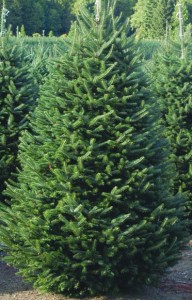Fraser Fir
Fraser fir is a coniferous tree found in the southern Appalachians in southeastern America at high altitudes between 3,900 ft to 6,683 ft. This fir species, noted for having a strong turpentine scent, exhibit a well-proportioned appearance with good needle retention ability. It has a conical crown consisting of straight twigs that are sometimes angled slightly upwards. The branches of the young trees are more compact and dense compared to those of the matured ones.
Scientific Classification
| Kingdom | Plantae |
| Division | Pinophyta |
| Class | Pinopsida |
| Order | Pinales |
| Family | Pinaceae |
| Genus | Abies |
| Scientific Name | Abies fraseri |
Quick Information
| Other Names | Frazier fir/Frasier fir, southern balsam fir |
| Size | Grows up to 10-15 m (30-50 ft); highest, 25 m (80 ft); trunk diameter measures 40-50 cm (16-20 in); broadest 75 cm (30 in) |
| Leaves | Flattened, needle-like, arranged in a spiral manner on the twigs, have broad circular bases; 10-23 mm long, 2-2.2 mm wide; slightly notched and rounded tip; upper surface is glaucous or dark green while the lower surface has two silvery-white stomatal bands |
| Cones (Strobili) | Cylindrical, erect; 3.5-7 cm (1.4-2.75 in) long, 2.5-3 cm (1-1.2 in) wide; dark purple when young, turn to light brown as they mature; have pale purple, yellow or green bract scales that are usually resinous |
| Tree Type | Evergreen |
| Bark | Smooth, narrow; it is gray-brown with many resin blisters when immature, but become scaly and cracked with age |
| Distribution/Range | Appalachian Mts. in SW Virginia, eastern Tennessee, and western North Carolina in the US |
| Hardiness Zones | 4-7 |
| Growth Rate | Slow to medium; average yearly increase is 8 to 12 inches |
| Growing Conditions | Winter Conditions: Average winter temperature varies between 28° F and 30° F (-2° C and -1° C)Summer Conditions: Mild summers with temperatures averaging at 60° F (16° C). Fog: Fog cover in summer is crucial, contributing to precipitation and providing a cooling effect Rain: Average annual precipitation of 75-100 inches (1,900-2,540 mm) Sunlight: Full sun as well as partial shade Soil Requirements: Shallow, rocky, extremely acidic soil supported by a layer of sandy subsoil |
| Diseases and Pests | Older trees are susceptible to heart rots; two-spotted spider mites cause discoloration and loss of needles; the Phytophthora fungus may cause root rot; a significant number of mature trees are killed by the balsam wooly adelgid insects |
| Flowering/Fruiting | Monoecious, with the female flowers being borne on the top of the crown while the male ones below the females; flower buds open during mid May-early June; cones break up when they are 4-6 months old |
| Seed production | Begins when the tree is 15 years old; dispersal of seeds takes place between September and mid-October |
| Seedling development | Epigeal germination; development is good on moss, peat, mineral soil, and litter |
| Wildlife Value | The red squirrel feeds on the terminal buds and seeds, the white-tailed deer occasionally grazes on its leaves and twigs |
| Cultivars | Crosses of Abies fraseri and Abies balsamea have been produced successfully; A. fraseri cv. ‘Prostrata’ is used as an ornamental tree |
| Uses | Offers watershed protection since it binds the shallow soil with the wet mountain slopes; used as a Christmas tree because of its sweet fragrance, green foliage, and beautiful shape; also used for making Christmas wreaths, garlands, candle rings, and centerpieces |
| IUCN Conservation Status | Endangered |
Identification and Comparison with Other Firs
Balsam fir vs. Fraser fir: The curved bracts on Fraser firs are longer than the scales of cones while those on balsam firs are comparatively shorter than their cone scales
Douglas fir vs. Fraser fir: Douglas firs grow well over 200 feet and are much taller than the Fraser firs; the branches and needles of Douglas fir are more closely bunched than the Fraser’s
Interesting Facts
- This fir species is named after John Fraser, a Scottish botanist who traveled to the Appalachians during the 18th century, and made several botanical discoveries.
- The Fraser fir was earlier referred to as the “she-balsam” because the blisters on its bark produce a milk-like viscous secretion or resin.
- A variety of balsam fir called Abies balsamea phanerolepis, found in North and West Virginia, is considered to be a natural hybrid of Abies fraseri (Fraser fir) with Abies balsamea (Balsam fir).
References:
- https://en.wikipedia.org/wiki/Fraser_fir
- https://www.fs.usda.gov/database/feis/plants/tree/abifra/all.html
- https://realchristmastrees.org/education/tree-varieties/fraser-fir/
- https://www.iucnredlist.org/species/32101/2810241
- http://www.wolfcreektreefarm.com/caring-for-a-fraser-fir-christmas-tree.php










